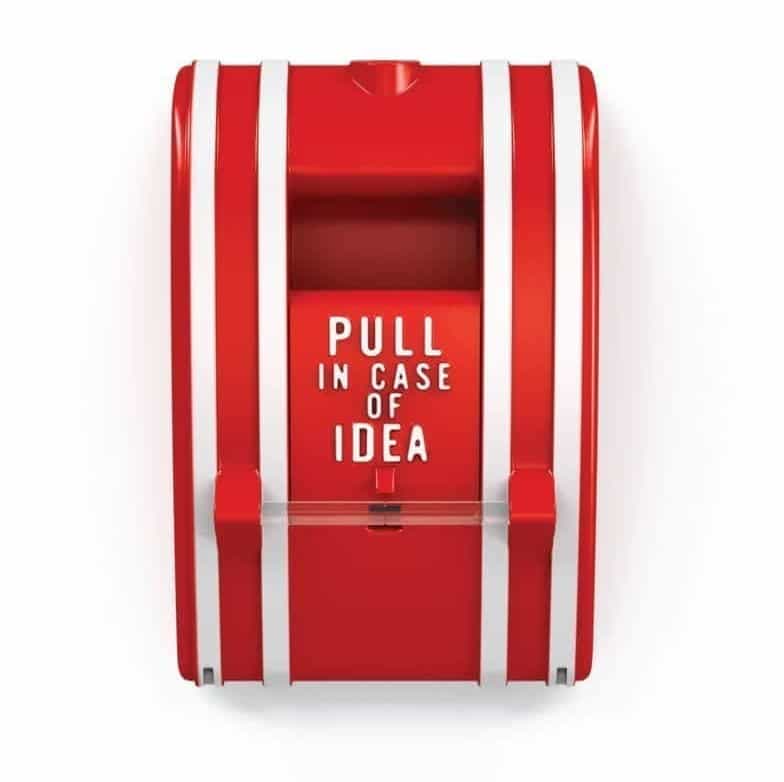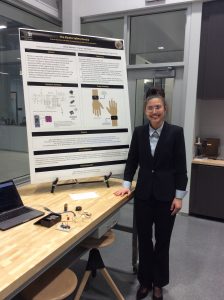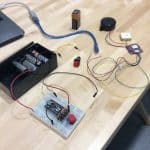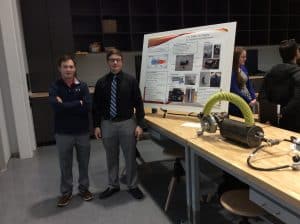Creative Kick-Start Award Winning Projects!
The Creative Kick-Start program was developed by the Engineering Library & the Engineering Technology Centers to encourage engineering students (undergraduate and graduate) to explore and develop projects. Students submit proposals which are reviewed by the Application Review Committee. Up to 10 wining projects receive funding – $500 which must be used in the Engineering Electronic Shop & Machine Shop. The funds for these projects are generously provided by the Engineering Technology Centers.
The Kick-Start program encourages innovation and learning new skills, while acknowledging that failing – and learning from those failures – is an important part of the creative process!
Seven Kick-Start winners presented project posters at the College of Engineering Research Open House this year. We are very excited about the projects which were developed.
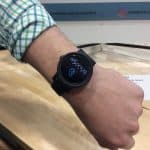
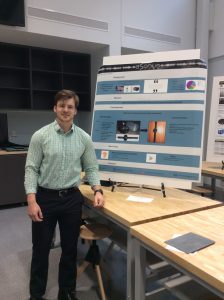 Adam Hoffman and Philip Abangan developed the “Asonus Tech” – an alerting device for the hearing-impaired. Their initial idea was to develop a small wearable device which would vibrate to alert the wearer to loud sounds in the environment (doorbells, fire alarms, etc.). Their project evolved into a smart-watch app rather than a stand alone product. Currently the app can be set to recognize some sounds, but due to limitations of available sound databases and limitations with computer processing power when performing analysis of sounds it creates some false positives. Hoffman and Abangan plan to continue to refine the app and eventually have it in the Google Play Store as an Alpha testing product. During the process they there were challenges – debugging code, for instance – but they learned more about coding, soldering and using a 3D printer. We look forward to seeing this app widely available!
Adam Hoffman and Philip Abangan developed the “Asonus Tech” – an alerting device for the hearing-impaired. Their initial idea was to develop a small wearable device which would vibrate to alert the wearer to loud sounds in the environment (doorbells, fire alarms, etc.). Their project evolved into a smart-watch app rather than a stand alone product. Currently the app can be set to recognize some sounds, but due to limitations of available sound databases and limitations with computer processing power when performing analysis of sounds it creates some false positives. Hoffman and Abangan plan to continue to refine the app and eventually have it in the Google Play Store as an Alpha testing product. During the process they there were challenges – debugging code, for instance – but they learned more about coding, soldering and using a 3D printer. We look forward to seeing this app widely available!
Ashley Mathews‘ idea was to create the Kineta – a self-defense device which would shock attackers on contact. Her device is now in the circuit- and bread board- phase and now aimed at providing a buzzer and GPS signal as an alert system. Mathews had several challenges to overcome: design process (transforming from an electrical shocking glove to a GPS locating device), learning about liability and weapons on campus, prototyping issues – working with the Arduino mini and the other parts which have with different connectors and learning how to modify the parts so they could work together. During her project process she learned about coding, breadboarding, and circuitry. She found she enjoyed the process so much she changed her major to Electrical & Computer Engineering, with an emphasis on the hardware side. As she takes more classes and learns more she hopes to make the Kineta smaller and more user-friendly. She also would like to work with emergency responders to create a device that will work with their systems.
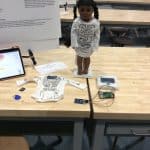
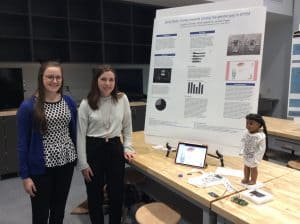 Body Betty is the brainchild of Caroline Chelsvig and Emily Leibold. The idea was to create a way to teach anatomy using a doll and an app. Their goal is to introduce young girls to STEM concepts. They planned to use a Raspberry Pi to house an RFID receiver and have a screen to display the app. The RFID would enable the user to tap the various parts of the doll to answer anatomy questions. However, the Raspberry Pi has too few pins to accommodate the screen and the RFID. Their HTML page worked perfectly! They plan to continue to refining the product. Neither Chelsvig nor Leibold have backgrounds in circuitry or programming or RFID technology so their biggest challenge was underestimating the time it would take to learn the new skills.
Body Betty is the brainchild of Caroline Chelsvig and Emily Leibold. The idea was to create a way to teach anatomy using a doll and an app. Their goal is to introduce young girls to STEM concepts. They planned to use a Raspberry Pi to house an RFID receiver and have a screen to display the app. The RFID would enable the user to tap the various parts of the doll to answer anatomy questions. However, the Raspberry Pi has too few pins to accommodate the screen and the RFID. Their HTML page worked perfectly! They plan to continue to refining the product. Neither Chelsvig nor Leibold have backgrounds in circuitry or programming or RFID technology so their biggest challenge was underestimating the time it would take to learn the new skills.
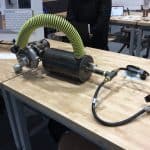 Greg Beaver and Walker Jarvie explored the science behind a jet engine by taking a car turbocharger and turning it into a jet engine. They were able to make the engine work for a few seconds at a time, but learned that once they removed compressed air the engine failed to intake enough air to continue the reaction. The challenges they encountered included the expense of the parts and the tools they had were limited. Safety was also a big concern. They did learn how modify a car turbo and properties of propane gas, but because of expense and safety concerns they won’t be moving forward on this project.
Greg Beaver and Walker Jarvie explored the science behind a jet engine by taking a car turbocharger and turning it into a jet engine. They were able to make the engine work for a few seconds at a time, but learned that once they removed compressed air the engine failed to intake enough air to continue the reaction. The challenges they encountered included the expense of the parts and the tools they had were limited. Safety was also a big concern. They did learn how modify a car turbo and properties of propane gas, but because of expense and safety concerns they won’t be moving forward on this project.
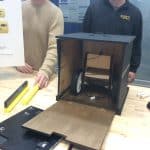
 Olivia Laux, Kaylin Slinskey, Lucinda Williamson, Jared McClung, and Bryan Williams set out to produce a a way to reduce damage to an individual’s wheelchair during commercial travel, thus encouraging more confident and independent travel experiences from wheelchair users. They developed a collapsible crate which would marketed to airlines and which would protect the wheel chair during flight. The crate would be collapsed and stored until needed. During the design process that developed a 3D printed hinge because hinges which are commercially available and within their budget were too weak to meet their needs. Their biggest challenge was working within a budget. Materials and testing of the product were both expensive. This challenge taught them to manage their resources and to keep their ideas in line with available materials/funds, testing and manufacturing. They worked around some of these constraints (expensive of a wheelchair, for instance), they worked with a smaller box and wheelchair to do their testing.
Olivia Laux, Kaylin Slinskey, Lucinda Williamson, Jared McClung, and Bryan Williams set out to produce a a way to reduce damage to an individual’s wheelchair during commercial travel, thus encouraging more confident and independent travel experiences from wheelchair users. They developed a collapsible crate which would marketed to airlines and which would protect the wheel chair during flight. The crate would be collapsed and stored until needed. During the design process that developed a 3D printed hinge because hinges which are commercially available and within their budget were too weak to meet their needs. Their biggest challenge was working within a budget. Materials and testing of the product were both expensive. This challenge taught them to manage their resources and to keep their ideas in line with available materials/funds, testing and manufacturing. They worked around some of these constraints (expensive of a wheelchair, for instance), they worked with a smaller box and wheelchair to do their testing.
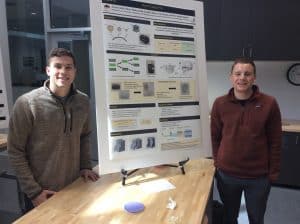
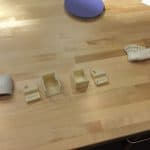 The Root Canal Pal was created by Ethan Slater, Collin Zweifel, Annie Cahill, Shao Yang Zhang, and Nina VanDerZanden. Their goal was to create a device that will stimulate large nerve fibers in the facial area. It will mask the brain’s perception of pain and work in tandem with existing local anesthetic administration. They used the idea of the Buzzy® which uses vibrations to override pain from needles. Their device would stimulate the nerves where they connect in the jaw in order to override the pain during dental procedures. They developed a skin, fat, and bone analog to test the vibration and created a housing for the vibration device which attaches directly to the dentists’ safety glasses. The fact that this would be used in a medical office presented the challenge of sterilizing the device for repeated use. They also studied the best way to measure vibrations. This group is in conversation with faculty in the Dentistry College to determine usability and to receive input.
The Root Canal Pal was created by Ethan Slater, Collin Zweifel, Annie Cahill, Shao Yang Zhang, and Nina VanDerZanden. Their goal was to create a device that will stimulate large nerve fibers in the facial area. It will mask the brain’s perception of pain and work in tandem with existing local anesthetic administration. They used the idea of the Buzzy® which uses vibrations to override pain from needles. Their device would stimulate the nerves where they connect in the jaw in order to override the pain during dental procedures. They developed a skin, fat, and bone analog to test the vibration and created a housing for the vibration device which attaches directly to the dentists’ safety glasses. The fact that this would be used in a medical office presented the challenge of sterilizing the device for repeated use. They also studied the best way to measure vibrations. This group is in conversation with faculty in the Dentistry College to determine usability and to receive input.
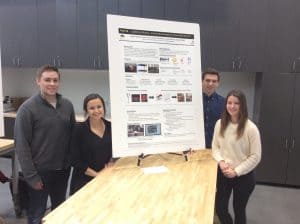 The Optimus Prone: Improved Shoulder Rehabilitation is the project James Cory, Jayme Waite, Dakota Streit, Cecily Calcopietro, and Isaak Moore have been developing. Their goal is to create a shoulder rehabilitation table which may be adjusted for differing body sizes. Therapists do several exercises with patients, however each therapist has their own way of doing them to work around body sizes and table limitations. The hope is that the adjustable table would standardize the exercises. A challenge they faced was the expensive in developing a table which would raise and lower. Fortunately an old dentist chair had been donated to one of the labs and the group was able to deconstruct that and use the mechanism in their table. They learned testing designs and protocols while working on their project. They have now finished the design phase and are waiting for parts to come in so they will be able to construct the table for the final presentation of their Senior Design Project.
The Optimus Prone: Improved Shoulder Rehabilitation is the project James Cory, Jayme Waite, Dakota Streit, Cecily Calcopietro, and Isaak Moore have been developing. Their goal is to create a shoulder rehabilitation table which may be adjusted for differing body sizes. Therapists do several exercises with patients, however each therapist has their own way of doing them to work around body sizes and table limitations. The hope is that the adjustable table would standardize the exercises. A challenge they faced was the expensive in developing a table which would raise and lower. Fortunately an old dentist chair had been donated to one of the labs and the group was able to deconstruct that and use the mechanism in their table. They learned testing designs and protocols while working on their project. They have now finished the design phase and are waiting for parts to come in so they will be able to construct the table for the final presentation of their Senior Design Project.
Congratulations to these outstanding students and their amazing and innovative projects! Well done!
